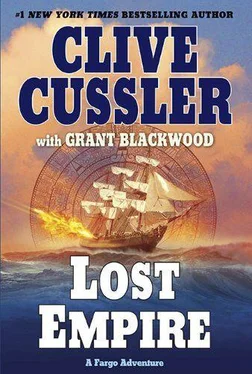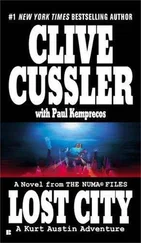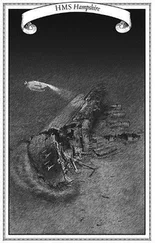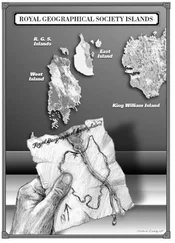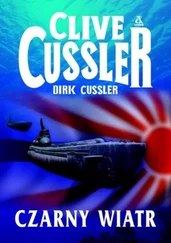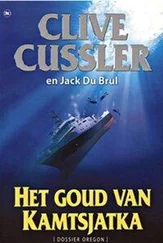“W.”
“You said the Sunda Strait, correct?” Sam asked.
“Yes.”
Sam paused. He closed his eyes for a moment, a half smile on his face. Remi asked, “What is it?”
“Blaylock left Bagamoyo on August 3, 1883. Based on his estimated transit time, he would have arrived in the Sunda within a day or two of August twenty-seventh.”“Okay . . .”
“The Sunda Strait was where the Krakatoa volcano was. August twenty-seventh was the day it exploded.”
ASHISTORY BUFFS, SAM AND REMI WERE WELL FAMILIAR WITH the 1883 eruption of Krakatoa. The archipelago, which covers roughly eight square miles of ocean, sits almost dead center in the Sunda Strait between Java and Sumatra and consisted of three islands prior to the cataclysm: Lang, Verlaten, and Rakata-the largest island in the group and home to the three volcanic cones collectively known as Krakatoa. Having undergone three major eruptions in the centuries prior to 1883, Krakatoa was no stranger to turmoil.
On May twentieth, three months prior to the final explosion, a great slash appeared in the side of Perbuatan, the northernmost cone, and steam began venting, along with plumes of ash that rose twenty-two thousand feet into the atmosphere. The residents of the nearby towns and villages, having witnessed such activity before, paid little attention, and by the end of the month their disinterest seemed validated. Krakatoa settled and remained mostly quiet for the next month.
On June sixteenth the eruptions began again, blanketing great swaths of sea and land with jet-black smoke for nearly a week. When the haze cleared, massive ash columns could be seen streaming from two of Krakatoa’s cones. Tides in the straits began running high, and ships at anchor had to strengthen their moorings lest they be beached.
Three weeks passed. Krakatoa’s two cones were joined by the third, and soon ash began accumulating on nearby islands, in some places up to two feet thick, killing flora and fauna and turning once-lush forests into moonscapes.
The eruptions continued through the end of June and into mid-August. On the twenty-fifth of August, at one o’clock in the afternoon, Krakatoa went into its paroxysmal phase. Within an hour, a black cloud of ash had risen eighteen miles into the sky, and the eruptions were nearly continuous. Fifteen and twenty miles away, ships were bombarded by hot pumice stones the size of softballs. By early evening, as darkness fell over the strait, minor tsunamis were rolling ashore on Java and Sumatra. The next morning, just before sunrise, Krakatoa went into its final death throes. A series of three eruptions, each one more powerful than the next, shook the area. So loud were the explosions that they were heard in Perth, Australia, two thousand miles to the southeast, and in the Mauritius Islands, three thousand miles to the west.
The resulting tsunamis, one for each eruption, radiated outward from Krakatoa at speeds up to one hundred twenty-five miles per hour, bulldozing their way onto the shores of Java and Sumatra and inundating islands as far away as fifty miles.
AT 10:02, KRAKATOA ISSUED its final salvo with an explosion equal to twenty thousand atomic bombs. The island of Krakatoa tore itself apart. The erupting cones, having ejected all their magma, collapsed in on themselves, taking with them fourteen square miles of the island and gouging out a caldera four miles wide and eight hundred feet deep. The resulting tsunami wiped out whole villages, killing thousands within minutes. Trees were uprooted, and the land stripped of every scrap of vegetation.
Following on the heels of the massive wave came the pyroclastic flows, gargantuan avalanches of fire and ash that roared down Krakatoa’s flanks and into the Sunda Strait. Traveling at eighty miles per hour and reaching temperatures in excess of twelve hundred degrees Fahrenheit, the surge boiled the ocean’s surface below it, creating a cushion of steam that carried it thirty miles or more, charring or entombing everything in its path, man-made and natural alike.Within hours of final explosion, what remained of Krakatoa fell silent. In the space of thirty hours, between 36,000 and 120,000 people lost their lives.
SUNDA STRAIT,
JAVA SEA, INDONESIA
THE LOUDSPEAKER IN THE CORNER OF THE PATIO CAFE CAME TO life: “Attention, all ticketed passengers: The Krakatau Explorer will be departing the docks in five minutes. Please board via the aft gangway.” The message repeated in Indonesian, French, German, then once more in English.
Sam and Remi, sitting at a corner table beside a trellis covered in blooming bougainvillea, finished their coffee and stood up. Sam dropped a pair of five-thousand-rupiah notes on the table, and they stepped out from under the awning and onto the dock.“Any sign of them?” Remi asked. “No. You?”
“No.”
Earlier that morning, as the Krakatau Explorer tour van pulled out of the Four Seasons turnaround, Sam thought he’d caught a glimpse of Itzli Rivera, but they’d seen nothing more during the ninety-minute ride from Jakarta to the Carita Beach Resort docks. While riding in a van packed with other tourists wasn’t Sam and Remi’s preferred style of adventuring, they were keenly aware that if Rivera and his men were, in fact, here, being caught alone on a lonely road in the Javan rain forests could be disastrous.
Moreover, this boat tour of what remained of the Krakatoa volcano and the newly opened Krakatau Museum was not only a first step in following Blaylock’s ill-fated trail-if there was one left to follow-but also an efficient way of drawing Rivera out and forcing his hand. The last thing the Mexican needed was to lose his quarry yet again. For Sam and Remi, it was akin to swimming with sharks: Better to have them in sight than wondering when they were going to swim out of the gloom and attack.
They joined the line of last-minute boarders at the aft gangplank, then boarded and chose a spot at the starboard rail. The Krakatau Explorer was a hundred-twenty-foot flat-bottomed skiff ferry with an oblong, pitch-roofed wheelhouse nestled high on the forecastle. The afterdeck, measuring eighty feet by forty feet, was divided into rows by blue-vinyl-covered bench seating.Sam kept one eye on the docks while Remi scanned the other passengers; she estimated there were sixty aboard. “Still nothing,” she said.
“Here too.”
On the dock, a pair of workers detached the gangplank and pulled it away from the ferry. A crewman on deck shut the gate. The mooring lines were singled up and hauled aboard. Three more crewmen appeared at the rail and pushed off the dock with poles. With a blare from the Explorer’s whistle, the engines started, and the ferry chugged away from the docks and headed west into the strait.
THREE HOURS LATER an Indonesian-accented voice came over the intercom: “Ladies and gentlemen, shortly the captain will be bringing the Krakatau Explorer around the island’s headland for our approach to the museum.”
As promised, within minutes the ferry turned to port and headed east along the island’s north shoreline. Passengers crowded the rail to stare up at the sheer, two-thousand-foot-high cliff-all that remained when the majority of the island collapsed into the sea.
THE FERRY PULLED ALONGSIDE the museum’s dock, and the mooring lines were secured and the gangplank lowered. Sam and Remi disembarked and headed toward the main building. Anchored to the seabed at the western edge of the caldera, the five-thousand-square-foot museum was constructed of inch-thick tempered glass and white-painted steel crossbeams. According to the brochure Sam and Remi had picked up at the Four Seasons, the museum contained the single largest collection of Krakatoa memorabilia and source material in the world.
Читать дальше
